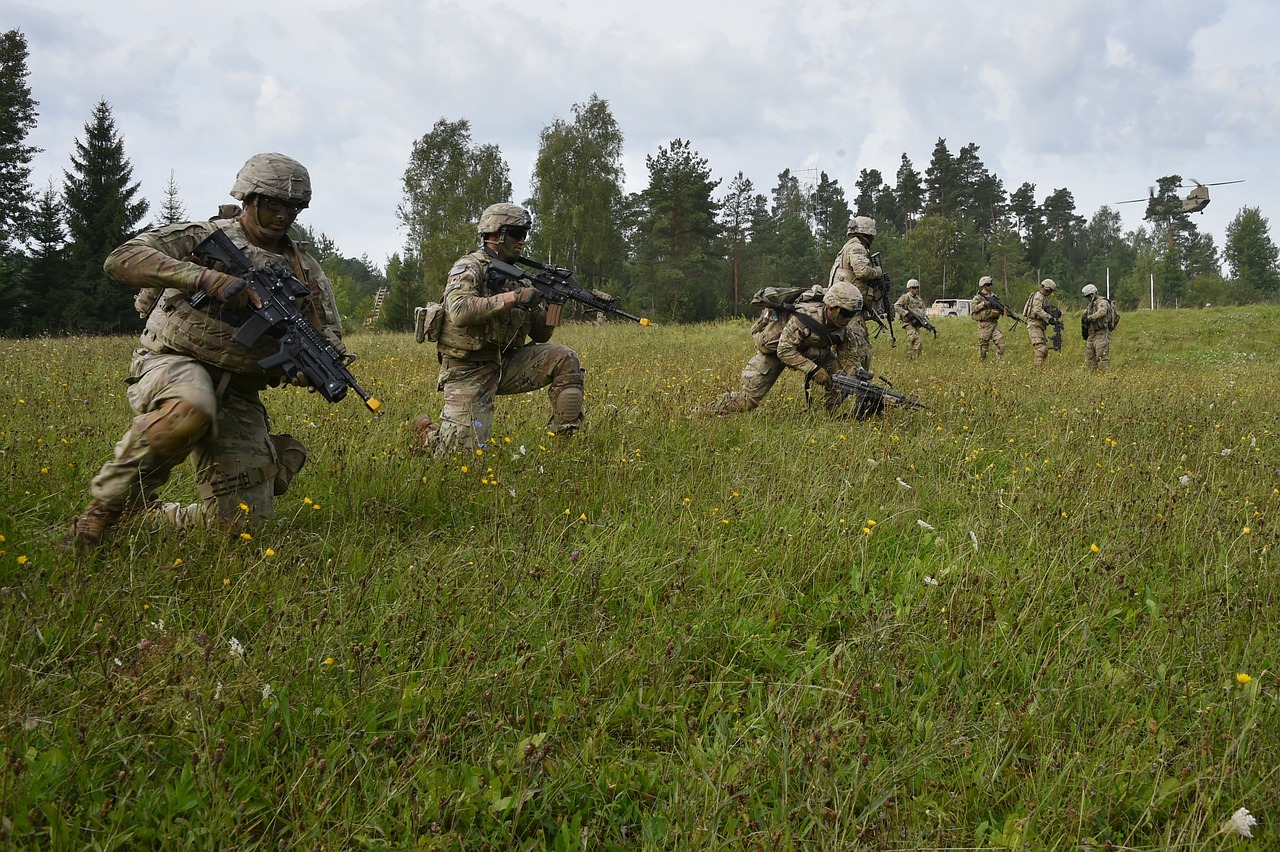How Deep Learning is Transforming Military Intelligence
In today's rapidly evolving technological landscape, deep learning stands at the forefront of innovation, particularly in the realm of military intelligence. This transformative technology is not just a buzzword; it is reshaping how military operations are conducted, enhancing decision-making processes, and improving operational efficiency. With its ability to analyze vast amounts of data in real-time, deep learning is paving the way for more informed strategies and quicker responses on the battlefield. Imagine having a system that can sift through mountains of data, identify patterns, and provide actionable insights almost instantaneously. This is the power of deep learning.
As we delve deeper into this topic, we will explore the various applications of deep learning within military intelligence, uncovering how it enhances surveillance, predictive analytics, and operational readiness. However, it's essential to recognize that with great power comes great responsibility. While the benefits are substantial, there are significant challenges and ethical considerations that must be addressed. As we navigate through this complex landscape, we will also speculate on the future of deep learning in military operations, highlighting emerging trends that could redefine warfare as we know it.
At its core, deep learning is a subset of machine learning that utilizes neural networks to process and analyze data. Unlike traditional machine learning techniques, which often rely on manual feature extraction, deep learning algorithms automatically discover patterns in data, making them incredibly powerful for tasks such as image and speech recognition. This ability to learn from vast datasets allows deep learning models to improve their performance over time, adapting to new information and scenarios.
To visualize this, think of deep learning as a sophisticated detective with an uncanny ability to piece together clues from a chaotic crime scene. While a traditional detective might focus on a few obvious leads, the deep learning detective can analyze countless details, uncovering hidden connections that would otherwise go unnoticed. This capability is particularly valuable in military intelligence, where the stakes are high, and the need for accurate information is paramount.
The applications of deep learning in military intelligence are both vast and varied, impacting numerous facets of modern warfare. From enhancing surveillance systems to improving threat detection, deep learning is revolutionizing how military operations are conducted. Let's explore some specific use cases:
One of the most significant advancements brought about by deep learning is the enhancement of surveillance systems. By leveraging real-time analysis of video feeds, deep learning algorithms can identify potential threats and monitor activities with unparalleled accuracy. Imagine a military drone equipped with deep learning capabilities, capable of distinguishing between civilians and combatants in a crowded urban environment. This level of situational awareness is crucial for minimizing collateral damage and ensuring the safety of both military personnel and civilians.
Facial recognition technology, powered by deep learning, has become a game-changer in military settings. It enables the identification of individuals in real-time, streamlining processes that were once tedious and time-consuming. However, this technology also raises ethical questions regarding privacy and the potential for misuse in combat zones. The balance between security and ethical considerations is a delicate one, and military leaders must navigate these challenges carefully.
Deep learning also plays a pivotal role in object detection and tracking systems. These systems can identify and monitor potential threats, significantly improving response times and operational accuracy. For instance, a deep learning model could analyze footage from a surveillance camera and instantly alert personnel to suspicious behavior, allowing for rapid intervention. This capability not only enhances operational readiness but also ensures that military resources are deployed effectively.
Another fascinating application of deep learning in military intelligence is the use of predictive analytics. By analyzing historical data and current trends, deep learning models can help military strategists forecast potential scenarios, informing tactical planning and resource allocation. This data-driven approach allows for more strategic decision-making, reducing the element of uncertainty that often accompanies military operations.
Despite the numerous benefits of deep learning in military intelligence, it is not without its challenges. Issues such as data quality, algorithm bias, and interpretability pose significant hurdles that must be addressed. For instance, the effectiveness of deep learning models heavily relies on the quality of the data used to train them. If the data is flawed or biased, the outcomes can be misleading, potentially leading to critical errors in judgment.
Acquiring high-quality, relevant data for military intelligence purposes is a significant challenge. The military often operates in dynamic environments where data can be scarce or unreliable. Ensuring the integrity of the data used in deep learning models is essential for accurate analysis and decision-making.
The deployment of deep learning technologies in military contexts raises profound ethical questions. As we integrate advanced technologies into warfare and intelligence operations, we must consider the moral implications of these actions. Striking a balance between technological advancement and ethical responsibility is crucial for maintaining public trust and ensuring that military operations align with societal values.
As technology continues to evolve, the future of deep learning in military intelligence appears promising. Emerging trends such as the integration of artificial intelligence, advancements in data collection methods, and enhanced collaboration between military and civilian sectors are likely to further transform military operations. The potential for deep learning to revolutionize warfare is immense, but it is essential to approach these advancements with caution, ensuring that ethical considerations remain at the forefront of military strategy.
- What is deep learning? Deep learning is a subset of machine learning that uses neural networks to analyze and interpret vast amounts of data.
- How is deep learning used in military intelligence? Deep learning is used for surveillance, threat detection, predictive analytics, and improving operational efficiency.
- What are the ethical concerns surrounding deep learning in the military? Ethical concerns include privacy issues, the potential for bias in algorithms, and the implications of deploying advanced technologies in warfare.
- What challenges does deep learning face in military applications? Challenges include data quality, availability, and the interpretability of algorithms.
- What does the future hold for deep learning in military intelligence? The future includes advancements in AI integration, improved data collection methods, and a focus on ethical considerations in military operations.

Understanding Deep Learning
Deep learning is a fascinating and complex subset of machine learning that mimics the way humans learn and process information. At its core, deep learning utilizes neural networks—a series of algorithms that attempt to recognize underlying relationships in a set of data through a process that is akin to human reasoning. What sets deep learning apart from traditional machine learning techniques is its ability to automatically learn and improve from experience without being explicitly programmed. This means that instead of requiring human intervention to define features and rules, deep learning models can identify patterns and make decisions based on raw data.
Imagine teaching a child to recognize animals. Initially, you might show them pictures of cats and dogs, explaining the differences. Over time, however, they begin to recognize these animals on their own, even when they see new breeds or unfamiliar images. This is similar to how deep learning operates. By processing vast amounts of data through multiple layers of neurons, deep learning models can develop a nuanced understanding of the information presented to them.
The architecture of deep learning models can be quite intricate, often involving multiple layers of processing, which is why it's referred to as "deep." Each layer extracts different features from the data, allowing for a more comprehensive understanding. For example, in image recognition tasks, the first layer might identify edges, the second layer shapes, and subsequent layers might recognize specific objects like cars or people. This hierarchical approach enables the model to learn complex representations of data, making it incredibly powerful for tasks that involve large datasets.
To further illustrate the differences between deep learning and traditional machine learning, consider the following comparison:
| Aspect | Traditional Machine Learning | Deep Learning |
|---|---|---|
| Feature Extraction | Requires manual feature selection | Automatically learns features from raw data |
| Data Requirement | Works well with smaller datasets | Requires large amounts of data for training |
| Model Complexity | Typically simpler models | Highly complex models with many layers |
| Computational Power | Less resource-intensive | Requires significant computational resources |
As deep learning continues to evolve, its applications are becoming increasingly diverse and impactful, especially in fields such as military intelligence. The ability to analyze vast amounts of data quickly and accurately is a game-changer for decision-making processes, operational efficiency, and situational awareness. However, it’s essential to recognize that while deep learning offers remarkable capabilities, it also comes with challenges that need to be addressed to harness its full potential effectively.
- What is the main advantage of deep learning over traditional machine learning? The main advantage is its ability to automatically learn features from raw data without requiring manual intervention.
- How does deep learning impact military intelligence? Deep learning enhances military intelligence by improving data analysis, threat detection, and operational efficiency.
- What are some challenges faced by deep learning? Challenges include data quality, algorithm bias, and the need for significant computational resources.

Applications in Military Intelligence
Deep learning is revolutionizing military intelligence in ways that were once only imagined in science fiction. By harnessing the power of advanced algorithms and vast datasets, military organizations are now able to analyze information with unprecedented speed and accuracy. This transformation is not just about technological advancement; it’s about redefining how military operations are conducted. The applications of deep learning in military intelligence are numerous and impactful, ranging from enhanced surveillance systems to predictive analytics that inform strategic decision-making.
One of the most significant applications of deep learning is in the realm of surveillance and reconnaissance. Traditional methods of gathering intelligence often involve painstaking manual analysis of data. However, with deep learning algorithms, vast amounts of video footage can be processed in real-time, allowing military personnel to detect anomalies and respond to threats almost instantaneously. Imagine a scenario where a military unit is deployed in a conflict zone, and they have access to a system that can analyze live video feeds from drones, identifying potential threats while filtering out irrelevant information. This capability not only improves situational awareness but also enhances operational readiness.
Deep learning algorithms have significantly improved surveillance systems by enabling real-time analysis of video feeds. These systems are capable of distinguishing between benign activities and potential threats, which is crucial in high-stakes environments. For instance, if a drone is monitoring a crowded area, deep learning can help identify unusual movements or behaviors that may indicate a security risk. This level of analysis allows military forces to allocate resources more effectively and respond to situations before they escalate.
Facial recognition technology, powered by deep learning, is another game-changer in military intelligence. This technology enhances identification processes in combat zones, allowing military personnel to quickly recognize individuals of interest. However, the use of facial recognition raises ethical considerations, particularly regarding privacy and potential misuse. It’s essential for military organizations to balance the advantages of this technology with the moral implications of its deployment. The effectiveness of facial recognition can be illustrated in scenarios where identifying a known adversary in a crowd can prevent potential attacks, but the question remains: at what cost?
Object detection and tracking systems that utilize deep learning are also critical in military operations. These systems can identify and monitor potential threats, such as vehicles or individuals, with remarkable precision. By employing deep learning algorithms, military units can enhance their response times and accuracy during operations. For example, if a suspicious vehicle is detected approaching a military base, the system can immediately alert personnel, allowing them to take proactive measures. This capability is vital in modern warfare, where the speed of information can mean the difference between success and failure.
Predictive analytics, driven by deep learning, aids military strategists in forecasting potential scenarios. By analyzing historical data and current trends, military leaders can make informed decisions about resource allocation and tactical planning. This data-driven approach allows for greater flexibility and adaptability in military operations. For instance, if data indicates a high likelihood of conflict in a specific region, military resources can be strategically positioned in advance. This proactive stance not only enhances operational efficiency but also minimizes risks to personnel.
In summary, the applications of deep learning in military intelligence are vast and varied, providing significant advantages in surveillance, threat detection, and strategic planning. As these technologies continue to evolve, they will undoubtedly play an increasingly crucial role in shaping the future of military operations.
- What is deep learning?
Deep learning is a subset of machine learning that uses neural networks to analyze and interpret large amounts of data.
- How does deep learning improve military surveillance?
Deep learning enhances military surveillance by enabling real-time analysis of video feeds, allowing for quicker identification of potential threats.
- What are the ethical concerns surrounding deep learning in military applications?
Ethical concerns include privacy issues, the potential for algorithmic bias, and the implications of using advanced technologies in warfare.
- Can deep learning predict future military scenarios?
Yes, predictive analytics driven by deep learning can forecast potential scenarios by analyzing historical data and current trends.

Enhanced Surveillance Systems
In an age where information is power, have become the backbone of military intelligence. Imagine a world where every movement is monitored, every threat analyzed in real-time, and every decision made is backed by data. This is not just a futuristic fantasy; it's the reality brought forth by deep learning technologies. By leveraging advanced algorithms, military forces can now process vast amounts of video feeds from drones, satellites, and ground cameras, transforming raw data into actionable insights.
These systems utilize neural networks to identify patterns and anomalies within the surveillance data. For instance, a deep learning model can be trained to recognize specific vehicles or even human behaviors that may indicate suspicious activity. This capability significantly enhances situational awareness, allowing military personnel to respond more effectively to potential threats. With the ability to analyze video feeds in real-time, military operations can achieve a level of operational readiness that was previously unattainable.
Moreover, the integration of deep learning into surveillance systems not only improves efficiency but also reduces the cognitive load on human operators. Traditionally, analyzing hours of footage required intense focus and could easily lead to oversight. However, with deep learning, the system can flag critical events, allowing operators to concentrate on strategic decision-making rather than sifting through endless streams of data.
One of the most remarkable features of these enhanced surveillance systems is their adaptability. As military environments are dynamic and ever-changing, the algorithms can be continuously updated with new data, ensuring they stay relevant and effective. For example, if a new type of drone or vehicle is introduced, the system can learn to recognize it through additional training, making it a flexible asset on the battlefield.
However, it's essential to recognize that while these advancements offer substantial benefits, they also come with challenges. Issues such as data privacy, algorithm bias, and the potential for misuse must be addressed. Military organizations must navigate these ethical waters carefully to ensure that the deployment of such technologies does not infringe on individual rights or lead to unintended consequences.
In summary, enhanced surveillance systems powered by deep learning represent a significant leap forward in military intelligence capabilities. They not only improve situational awareness and operational efficiency but also pave the way for more informed decision-making. As we continue to explore the potential of these technologies, the military landscape will undoubtedly evolve, making the integration of deep learning systems a critical component of modern warfare.
- What are enhanced surveillance systems?
Enhanced surveillance systems are advanced technologies that utilize deep learning algorithms to analyze video feeds and other data sources in real-time, improving military situational awareness and response times. - How does deep learning improve surveillance?
Deep learning improves surveillance by enabling systems to recognize patterns, detect anomalies, and flag critical events, allowing for more efficient data processing and decision-making. - What are the ethical concerns associated with enhanced surveillance?
Concerns include data privacy, the potential for algorithm bias, and the misuse of surveillance technologies, which must be carefully managed to protect individual rights.

Facial Recognition Technology
Facial recognition technology, powered by deep learning, has emerged as a game-changer in military settings, revolutionizing the way personnel identify and track individuals in various scenarios. Imagine being able to pinpoint a potentially hostile individual in a crowded area within seconds—this is not science fiction; it’s the reality that deep learning algorithms are making possible. These systems analyze facial features from images or video feeds, converting them into unique digital signatures that can be matched against extensive databases.
One of the standout advantages of using deep learning for facial recognition is its remarkable accuracy. Traditional methods often struggled with variations in lighting, angle, and expression, but deep learning models can learn and adapt to these factors, enhancing their performance significantly. For instance, a study conducted by the Department of Defense revealed that deep learning algorithms could achieve over 95% accuracy in identifying faces under varied conditions, which is a substantial improvement over earlier technologies.
However, the deployment of facial recognition technology in military applications is not without its challenges. While the benefits are clear, ethical considerations loom large. The potential for misuse, such as unwarranted surveillance or violations of privacy, raises critical questions. Military personnel must grapple with the balance between operational efficiency and the rights of individuals. For instance, how do we ensure that this powerful tool is used responsibly? The implications of using facial recognition in combat zones can be profound, as it may lead to misidentifications or wrongful targeting if not carefully managed.
Moreover, the integration of facial recognition systems into military operations necessitates robust training and oversight. Personnel must be well-versed in the ethical guidelines surrounding the use of such technology, ensuring that they are not only effective in their roles but also respectful of human rights. The military is thus tasked with developing comprehensive training programs that emphasize both the operational capabilities of these systems and the ethical frameworks within which they must operate.
In summary, while facial recognition technology offers unparalleled advantages in enhancing military intelligence and operational effectiveness, it also demands a careful approach to its implementation. The future will likely see advancements that further refine these systems, but the focus must remain on ethical practices to prevent misuse. As we stand on the brink of this technological revolution, the question remains: how can we harness the power of facial recognition while safeguarding individual rights in an increasingly complex battlefield?
- What is facial recognition technology?
Facial recognition technology is a biometric system that uses deep learning algorithms to identify and verify individuals based on their facial features. - How does deep learning enhance facial recognition?
Deep learning improves facial recognition by enabling systems to learn from large datasets, allowing for greater accuracy in identifying faces under varying conditions. - What are the ethical concerns associated with facial recognition in the military?
Ethical concerns include potential violations of privacy, the risk of misidentification, and the need for responsible use to prevent abuse of power. - How accurate is facial recognition technology?
Modern deep learning-based facial recognition systems can achieve accuracy rates exceeding 95%, depending on the quality of the input data and conditions. - What training is required for military personnel using facial recognition technology?
Military personnel need training that covers both the technical aspects of the technology and the ethical considerations involved in its use.

Object Detection and Tracking
In the fast-paced world of military operations, have emerged as critical components in ensuring national security and operational success. Utilizing advanced deep learning algorithms, military forces can now identify and monitor potential threats with unprecedented accuracy and speed. Imagine having the capability to not only see what’s happening in a battlefield but also to understand it in real-time. This is the power that deep learning brings to the table.
At its core, object detection involves identifying instances of objects within images or video feeds, while tracking refers to the ability to follow these objects over time. When combined, these technologies create a robust system that enhances situational awareness. For instance, a military drone equipped with deep learning algorithms can analyze video footage to detect enemy vehicles or personnel, automatically tracking their movements without the need for constant human oversight. This capability significantly reduces the response time for military personnel, allowing them to make informed decisions quickly and efficiently.
One of the standout features of deep learning in object detection is its ability to learn from vast amounts of data. Traditional methods often struggled with varying conditions, such as changes in lighting or weather. However, deep learning models can adapt to these changes by training on diverse datasets. This adaptability is akin to a seasoned soldier who learns to navigate different terrains and environments, making them more effective in the field.
Moreover, the accuracy of these systems is remarkable. Advanced algorithms can achieve detection rates upwards of 90%, which is a game-changer for military operations. The ability to distinguish between friendly and hostile entities reduces the risk of collateral damage and enhances mission success rates. For example, during reconnaissance missions, deep learning-powered systems can quickly analyze live feeds and provide actionable insights, allowing commanders to make split-second decisions that could save lives.
However, it’s essential to recognize that with great power comes great responsibility. The deployment of object detection and tracking technologies raises several ethical questions. Who is responsible if an algorithm misidentifies a target? What measures are in place to ensure that these technologies are used appropriately? Addressing these concerns is vital to maintaining public trust and ensuring that military operations adhere to international laws and ethical standards.
In conclusion, object detection and tracking systems powered by deep learning represent a significant leap forward in military intelligence. They not only enhance operational efficiency but also contribute to better decision-making processes. As these technologies continue to evolve, their integration into military strategies will likely become even more sophisticated, paving the way for a future where military operations are safer and more effective. The journey is just beginning, and the implications for warfare and intelligence are profound.
- What is object detection in military applications?
Object detection refers to identifying and locating objects within images or video feeds, crucial for monitoring threats in military operations. - How does deep learning improve tracking capabilities?
Deep learning algorithms can analyze vast datasets to track objects over time, adapting to changes in the environment and providing real-time insights. - What are the ethical implications of using these technologies?
The use of object detection and tracking raises concerns about misidentification and accountability, necessitating strict guidelines to ensure responsible use.

Predictive Analytics in Operations
In the fast-paced world of military operations, predictive analytics powered by deep learning is emerging as a game-changer. Imagine being able to forecast potential scenarios before they unfold, akin to having a crystal ball that reveals the future of battlefield dynamics. This capability is not just a dream; it's becoming a reality thanks to the sophisticated algorithms and vast datasets that deep learning can harness.
By analyzing historical data and current trends, military strategists can gain invaluable insights into enemy movements, logistical challenges, and even potential weather impacts on operations. For instance, consider a scenario where a military unit is planning a mission in a region known for its unpredictable weather. Deep learning models can analyze past weather patterns alongside troop movements and mission outcomes to predict the most favorable conditions for success. This data-driven approach allows commanders to make informed decisions rather than relying on gut feelings or outdated intelligence.
Moreover, predictive analytics can enhance resource allocation. By forecasting the necessary supplies and personnel for upcoming operations, military planners can ensure that units are adequately equipped and prepared. This proactive stance not only increases operational efficiency but also minimizes waste and maximizes effectiveness. For example, if predictive models indicate that a particular operation will require more medical supplies than initially anticipated, commanders can adjust their logistics accordingly, ensuring that troops are supported no matter what challenges arise.
However, it’s essential to recognize that predictive analytics is not infallible. The accuracy of predictions heavily relies on the quality of the data fed into the system. Poor quality data can lead to misleading insights, potentially resulting in devastating consequences on the battlefield. To mitigate this risk, military organizations must invest in robust data collection and processing systems, ensuring that the information used for predictive analytics is both accurate and relevant.
As we venture further into the future, the integration of artificial intelligence and machine learning in predictive analytics will likely become more sophisticated. We can expect to see the development of even more advanced algorithms capable of processing vast amounts of data in real-time, providing military leaders with up-to-the-minute insights that could change the course of operations. The fusion of human intuition and machine learning could create a new paradigm in military strategy, where decisions are informed by data but tempered with human judgment.
In summary, the role of predictive analytics in military operations is poised to grow exponentially. As technology evolves, the ability to predict outcomes and strategize accordingly will not only enhance operational efficiency but could also save lives. The battlefield of the future will be defined by those who can leverage data to anticipate challenges and seize opportunities, making predictive analytics an indispensable tool in military intelligence.
- What is predictive analytics in military operations?
Predictive analytics in military operations involves using data analysis techniques to forecast future scenarios and outcomes, aiding in strategic decision-making. - How does deep learning enhance predictive analytics?
Deep learning enhances predictive analytics by processing vast amounts of data through advanced algorithms, leading to more accurate predictions and insights. - What challenges does predictive analytics face in military contexts?
Challenges include data quality, availability, and the potential for algorithm bias, which can affect the reliability of predictions. - Why is data quality important for predictive analytics?
High-quality data is crucial because inaccurate or irrelevant data can lead to misleading predictions, impacting operational decisions. - What is the future of predictive analytics in military intelligence?
The future looks promising, with advancements in AI and machine learning expected to enhance the capabilities and accuracy of predictive analytics in military operations.

Challenges and Limitations
While deep learning has undeniably revolutionized military intelligence, it is not without its challenges and limitations. As we dive into this complex realm, it's essential to recognize that the effectiveness of these advanced technologies hinges on several critical factors. One of the most pressing issues is the quality of data utilized in training deep learning models. In military contexts, acquiring high-quality, relevant data can be a daunting task. The data must be accurate, comprehensive, and timely to ensure that the algorithms function correctly. Unfortunately, the chaotic nature of combat zones and the vastness of operational theaters often lead to incomplete or biased datasets, which can skew the results of deep learning applications.
Moreover, the question of algorithm bias cannot be overlooked. Deep learning systems learn from the data they are fed, and if that data contains biases—whether intentional or not—the algorithms will likely perpetuate those biases. This can have serious implications in military operations, where decisions made based on flawed data can lead to misidentification of threats or even wrongful targeting. Consider a situation where a surveillance system misclassifies civilians as combatants due to biased training data; the consequences could be catastrophic. Therefore, ensuring the integrity and fairness of the datasets used is paramount.
Another significant challenge is the interpretability of deep learning models. Unlike traditional algorithms, which often provide clear, understandable outputs, deep learning models can be more like a black box. This lack of transparency can be problematic in military settings where decisions need to be justified and understood by human operators. If a military strategist cannot comprehend why a system has made a particular recommendation, it can lead to hesitancy in decision-making and a lack of trust in the technology. Thus, developing methods to enhance the interpretability of these models is crucial for their successful integration into military operations.
In addition to these technical challenges, there are also ethical considerations that must be addressed. The deployment of deep learning technologies in military contexts raises moral questions about the potential for misuse and the implications of autonomous decision-making in life-and-death situations. As we push the boundaries of what technology can achieve, we must also grapple with the responsibility that comes with it. Questions such as: "Who is accountable for the decisions made by these systems?" and "How do we ensure compliance with international laws and humanitarian standards?" are at the forefront of this discussion.
In summary, while deep learning offers exciting possibilities for enhancing military intelligence, it also presents a unique set of challenges and limitations that must be carefully navigated. From ensuring data quality and addressing algorithm bias to improving interpretability and considering ethical implications, the journey toward fully integrating deep learning into military operations is fraught with complexities. Addressing these challenges head-on will be essential for harnessing the full potential of deep learning technologies in the military domain.
- What are the main challenges of using deep learning in military intelligence?
The primary challenges include data quality, algorithm bias, interpretability, and ethical considerations. - How does data quality affect deep learning models?
High-quality data is essential for accurate predictions; poor data can lead to flawed results and misinformed decisions. - What is algorithm bias, and why is it a concern?
Algorithm bias occurs when a model reflects the prejudices present in its training data, leading to unfair or inaccurate outcomes. - Why is interpretability important in military applications?
Understanding the reasoning behind decisions made by deep learning models is crucial for trust and effective decision-making in military operations. - What ethical issues arise from using deep learning in warfare?
Ethical concerns include accountability for decisions made by autonomous systems and compliance with international laws.

Data Quality and Availability
The effectiveness of deep learning models in military intelligence is profoundly influenced by the quality and availability of data. Imagine trying to build a skyscraper without a solid foundation; that’s essentially what military strategists face when they attempt to leverage deep learning without high-quality data. The algorithms thrive on vast datasets, but if those datasets are flawed, outdated, or incomplete, the insights derived from them can lead to disastrous decisions on the battlefield.
One of the primary challenges is the acquisition of relevant data. Military operations generate copious amounts of data, but not all of it is useful for training deep learning models. Data must be meticulously curated to ensure it reflects the current operational environment. For instance, if a deep learning model is trained on outdated surveillance footage, it may fail to recognize new threats or changes in enemy tactics. This can severely compromise situational awareness and operational readiness.
Moreover, data quality is not just about quantity; it's also about accuracy. Inaccurate data can lead to algorithmic bias, where the model makes incorrect predictions based on flawed training data. This bias can skew threat assessments and lead to misallocation of resources. For example, if a facial recognition system is trained predominantly on images of a specific demographic, it may struggle to accurately identify individuals from other backgrounds, resulting in serious ethical and operational implications.
To address these challenges, military organizations must implement robust data governance frameworks. This includes:
- Data Collection Standards: Establishing clear protocols for data collection to ensure consistency and reliability.
- Regular Data Audits: Conducting periodic reviews of data quality to identify and rectify discrepancies.
- Collaborative Data Sharing: Engaging with allied forces to share data resources, thereby enriching the training datasets available for deep learning models.
Additionally, the availability of data is a critical factor. In many military contexts, sensitive information is often classified, limiting access to valuable datasets that could enhance deep learning applications. Striking a balance between operational security and the need for data transparency is essential. As military leaders navigate this complex landscape, they must consider innovative ways to anonymize and share data without compromising national security.
In conclusion, the path to harnessing the full potential of deep learning in military intelligence is paved with challenges related to data quality and availability. Addressing these issues head-on not only improves the accuracy and reliability of deep learning applications but also enhances the overall effectiveness of military operations. As technology continues to advance, ensuring that high-quality, relevant data is at the forefront of military intelligence strategies will be paramount.
- What is deep learning? Deep learning is a subset of machine learning that uses neural networks to analyze large amounts of data for pattern recognition and decision-making.
- How does data quality affect military intelligence? Poor data quality can lead to inaccurate predictions and decisions, compromising operational effectiveness and situational awareness.
- What are the ethical considerations of using deep learning in military contexts? Ethical concerns include issues of algorithmic bias, privacy, and the moral implications of automated decision-making in warfare.
- How can military organizations improve data quality? By implementing data collection standards, conducting regular audits, and fostering collaborative data sharing with allies.

Ethical Considerations
As we dive into the fascinating world of deep learning in military intelligence, it's crucial to pause and reflect on the ethical implications that come along with these powerful technologies. While the potential for enhanced decision-making and operational efficiency is enormous, we must also grapple with the moral responsibilities that accompany such advancements. After all, with great power comes great responsibility, right?
One of the primary concerns revolves around autonomous weapons systems. These AI-driven machines can make life-and-death decisions without human intervention, leading to a slippery slope of accountability. If a drone mistakenly targets civilians due to an algorithm error, who is held responsible—the programmer, the military, or the machine itself? This ambiguity raises profound questions about morality in warfare and the sanctity of human life.
Moreover, the use of facial recognition technology in combat zones introduces its own set of ethical dilemmas. While it can significantly enhance identification processes, the potential for misuse is alarming. Imagine a scenario where this technology is employed not just for identifying enemies, but also for surveillance on innocent civilians. Such actions could lead to violations of privacy rights and human dignity, setting a dangerous precedent in the name of national security.
Another pressing issue is the potential for algorithmic bias. Deep learning models are trained on data sets, and if these data sets are skewed or unrepresentative, the outcomes can be biased. For instance, if a model is trained predominantly on data from one demographic, it may fail to accurately assess threats from other groups. This not only compromises operational effectiveness but also risks reinforcing stereotypes and discrimination, which is particularly concerning in military contexts where lives are at stake.
To navigate these ethical waters, military organizations must implement strict guidelines and oversight mechanisms. This could include:
- Establishing clear accountability frameworks for AI-driven decisions
- Regularly auditing algorithms for bias and fairness
- Engaging with ethicists and legal experts to evaluate the implications of deploying advanced technologies
As we look to the future, it’s essential that we foster a culture of ethical mindfulness within military operations. This means not only embracing innovation but also ensuring that our moral compass guides us through the complexities of modern warfare. In doing so, we can harness the power of deep learning while upholding the values that define us as a society.
- What are the main ethical concerns regarding deep learning in military intelligence?
The primary concerns include accountability for autonomous decisions, misuse of surveillance technologies, and algorithmic bias. - How can military organizations ensure ethical use of deep learning technologies?
By establishing accountability frameworks, auditing algorithms for bias, and involving ethicists in the decision-making process. - What role does facial recognition technology play in military operations?
It enhances identification processes but raises significant privacy and ethical issues, especially regarding civilian surveillance.

The Future of Deep Learning in Military Intelligence
The future of deep learning in military intelligence is not just bright; it’s positively dazzling! As we stand on the brink of technological advancements that could redefine warfare and defense strategies, deep learning is poised to play a pivotal role. Imagine a world where military leaders can predict enemy movements with astounding accuracy or where autonomous drones can analyze threats in real-time, making decisions faster than any human could. This is not science fiction; this is the future we’re heading towards.
One of the most exciting prospects is the integration of deep learning with other emerging technologies. For instance, when combined with Internet of Things (IoT) devices, deep learning can enhance situational awareness by processing data from a myriad of sensors deployed across the battlefield. This interconnected web of devices can provide a comprehensive view of operations, allowing for quicker decision-making and more effective resource allocation.
Moreover, advancements in natural language processing (NLP) are set to revolutionize how military intelligence is gathered and analyzed. Imagine algorithms that can sift through mountains of unstructured data—like reports, social media posts, and communications—extracting valuable insights and identifying potential threats. This capability could significantly reduce the time it takes to gather actionable intelligence, giving military personnel the upper hand.
However, as we look forward, we must also consider the ethical implications of these advancements. The deployment of autonomous systems raises questions about accountability and decision-making in combat scenarios. Who is responsible if an AI makes a mistake? These are not just technical challenges; they are moral dilemmas that military leaders must address as they integrate deep learning into their operations.
In terms of training and education, the military will need to invest in developing a workforce that is not only skilled in traditional military tactics but also proficient in data science and machine learning. This shift will require a cultural change within military organizations, embracing technology and fostering an environment of continuous learning.
To summarize, the future of deep learning in military intelligence is filled with potential. With the right investments in technology, training, and ethical considerations, we could see a transformation in how military operations are conducted. The battlefield of tomorrow will be shaped by the algorithms of today, and it’s a thrilling prospect that could redefine the very nature of warfare.
- What is deep learning? Deep learning is a subset of machine learning that uses neural networks to analyze large datasets and make predictions or decisions based on that data.
- How is deep learning used in military intelligence? Deep learning is applied in various ways, including surveillance, threat detection, and predictive analytics, enhancing decision-making and operational efficiency.
- What are the ethical concerns surrounding deep learning in the military? Ethical concerns include accountability for decisions made by AI, the potential for bias in algorithms, and the implications of using autonomous systems in warfare.
- What does the future hold for deep learning in military operations? The future promises greater integration with emerging technologies, improved data analysis capabilities, and a need for a workforce skilled in both military tactics and data science.
Frequently Asked Questions
-
What is deep learning and how is it different from traditional machine learning?
Deep learning is a subset of machine learning that uses neural networks to process and analyze large amounts of data. Unlike traditional machine learning, which often relies on manual feature extraction, deep learning automatically learns features from the data through multiple layers of abstraction. This allows it to identify complex patterns and make predictions with greater accuracy.
-
How is deep learning applied in military intelligence?
Deep learning is transforming military intelligence in numerous ways. It's used for enhanced surveillance systems that analyze video feeds in real-time, facial recognition technology for identifying individuals in combat zones, and object detection systems that track potential threats. These applications significantly improve situational awareness and operational efficiency.
-
What are the benefits of using deep learning in military operations?
The benefits of deep learning in military operations include improved decision-making through predictive analytics, faster response times to threats, and enhanced accuracy in identifying targets. By leveraging vast amounts of data, military strategists can forecast scenarios and allocate resources more effectively, which is crucial during missions.
-
What challenges does deep learning face in military applications?
Despite its advantages, deep learning faces several challenges, including data quality and availability. The effectiveness of deep learning models is heavily dependent on the quality of the data used for training. Additionally, issues like algorithm bias and the interpretability of results can pose significant hurdles in military contexts.
-
Are there ethical concerns related to deep learning in military intelligence?
Yes, the use of deep learning in military contexts raises various ethical concerns. These include the potential for misuse of technology in warfare, privacy issues related to surveillance, and the moral implications of using automated systems for decision-making in life-and-death situations. It's essential to address these concerns to ensure responsible use of advanced technologies.
-
What does the future hold for deep learning in military intelligence?
The future of deep learning in military intelligence looks promising, with ongoing advancements in technology. Emerging trends may include more sophisticated algorithms, improved data integration methods, and enhanced capabilities for real-time decision-making. As these innovations unfold, they could further revolutionize military operations and intelligence gathering.



















